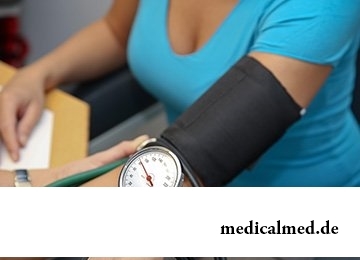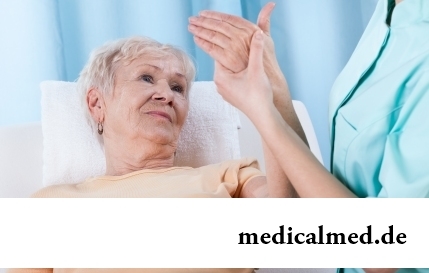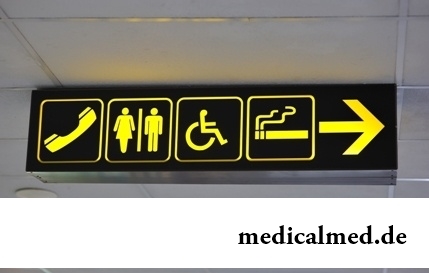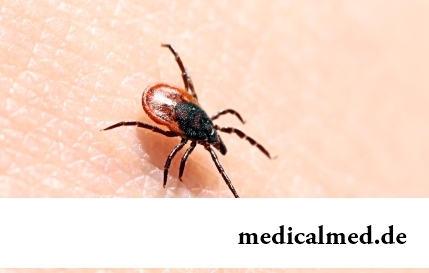





Intracranial hypertensia
 VChD (intracranial pressure) reflects the size of pressure of intracerebral liquid upon a brain. In the course of adaptation to the changing environment conditions this indicator can both increase, and to decrease. If VChD is steadily raised for a long time, then speak about a syndrome of intracranial hypertensia.
VChD (intracranial pressure) reflects the size of pressure of intracerebral liquid upon a brain. In the course of adaptation to the changing environment conditions this indicator can both increase, and to decrease. If VChD is steadily raised for a long time, then speak about a syndrome of intracranial hypertensia.
Reasons of intracranial hypertensia
Not all reasons causing this syndrome are obvious therefore before treatment careful diagnosis and inspection of the patient are necessary.
Most often the syndrome of intracranial hypertensia arises in the following situations:
- Long air hunger;
- Disturbance of outflow of a venous blood from a head cavity;
- Infectious damages of a brain and its covers (encephalitis, meningitis);
- Chronic obstructive pulmonary diseases;
- Heart failure;
- Craniocereberal injuries;
- Hydrocephaly;
- Intracranial tumor;
- Abscesses;
- Hematomas.
Quite often symptoms of intracranial hypertensia appear at children. In this case the reasons can become:
- Inborn defects;
- Prematurity;
- Long pre-natal hypoxia;
- Pathologies of pregnancy and childbirth;
- Pre-natal and neuroinfections.
Symptoms of intracranial hypertensia
At adults and children symptoms of intracranial hypertensia are various. At newborns it is shown by plentiful vomiting which does not depend on meal, frequent and long crying, lag in development (later begin to sit and creep, uncertainly hold a head etc.).
Indirect signs are too convex forehead or protrusion of a fontanel at the kid. The symptom "setting the sun" at which eyeballs are rolled up down to such degree that the thin white strip of a sclera from above is visible is characteristic of children with the raised VChD.
At teenagers and children of the advanced preschool and younger school age symptoms of intracranial hypertensia are:
- Sensitivity, tearfulness, drowsiness;
- Heartbeat;
- The increased arterial pressure;
- Flashes before eyes, squint;
- Spasms and nausea;
- Night and morning headache;
- Shadows under the eyes;
- Pain behind eye-sockets.
Symptoms of intracranial hypertensia at adults are similar to a picture of a course of a disease at teenagers. Except the listed signs it is also possible to note decrease in sexual function at men and a libido at women, meteosensitivity, the increased nervousness and bystry fatigue.
Benign Intracranial Hypertensia (BIH)
It is one of versions VChD which can be carried to a temporary phenomenon which is caused by a number of adverse factors. The condition of benign intracranial hypertensia is reversible and does not constitute serious danger as in this case squeezing of a brain happens not because of influence of any foreign body. The following factors can cause DVG:
- Hypovitaminosis;
- Obesity;
- Pregnancy;
- Hyperparathyreosis;
- Failures in a menstrual cycle;
- Cancellation of some drugs;
- Vitamin A overdose, etc.
Benign intracranial hypertensia is connected with disturbance of absorption or outflow of cerebrospinal liquid. Patients complain of the headaches amplifying at the movement, and sometimes even during the sneezing or cough. The main difference of a disease from classical hypertensia of a brain is that at the patient no signs of oppression of consciousness are observed, and the state has no effects and does not demand special treatment.
Diagnosis
For statement of a syndrome of intracranial hypertensia it is necessary to determine pressure in a skull. For this purpose into the canal of a backbone or liquid cavities of a cranium enter the special needle connected to the manometer. It is an unsafe and difficult procedure therefore for diagnosis often use other objective symptoms of intracranial hypertensia:
- Expansion and crimpiness of veins of an eyeground. In spite of the fact that it is an indirect symptom of increase in VChD, it is rather reliable;
- The disturbance of outflow of a venous blood established at ultrasonic examination of head vessels;
- Depression of marrow on edge of cerebral cavities and expansion of cavities with liquid. These signs are found at MRT (magnetic and resonant tomography) and CT (computer tomography);
- Use of the data obtained during the brain research by an ekhoentsefalografiya method.
Exact diagnosis and definition of extent of development of a disease are possible at a combination of all listed research methods, and also taking into account differentiation of symptoms of clinical implication of VChD.
Methods of treatment of intracranial hypertensia
Treatment of intracranial hypertensia is directed to reduction of amount of liquor and depends on a condition of the patient. At a high-quality form appoint diuretic drugs which, as a rule, are enough to facilitate a condition of the patient. In case traditional therapy is unacceptable (for example, in operating time), it is recommended to carry out special exercises.
 Well the sparing diet, the particular drinking treatment, physiotherapeutic procedures, acupuncture and manual therapy help. Sometimes the patient does even without medicines, and symptoms of a disease pass within the first week of correction.
Well the sparing diet, the particular drinking treatment, physiotherapeutic procedures, acupuncture and manual therapy help. Sometimes the patient does even without medicines, and symptoms of a disease pass within the first week of correction.
At treatment of the intracranial hypertensia caused by some other diseases originally remove the cause. So, at first it is necessary to get rid of a tumor which creates pressure in a skull, and only then to fight against the arisen effects.
In very hard cases, for example, when blocking brain liquid, to the patient implant special tubules which promote outflow of excessive cerebrospinal fluid.
It is possible to cure intracranial hypertensia only when the causes which caused this pathology are completely removed. At correctly picked up therapy improvement of a state is observed in 3-5 days after an initiation of treatment.
The first vibrator was invented in the 19th century. It worked at the steam engine and intended for treatment of female hysteria.

The words "disease" and "patient" not without reason come from one root – "pain". As a rule, symptoms of illnesses thoroughly spoil the patient...
Section: Articles about health
With age in a human body harmful substances collect. We receive them with food and water, at inhalation of the contaminated air, reception of medicines, use of household chemicals and cosmetics. A considerable part of toxins accumulates in a liver, osnovno...
Section: Articles about health
Impossibility to conceive the child – a trouble of many Russian families. During quite long time was considered that main "culprits" of troubles such are women. Modern physicians claim that the situation is different: about a half of failures in attempts of reproduction are connected with male infertility....
Section: Articles about health
Color of plants is caused by presence at them of certain chemical compounds. Let's talk that various colors mean vegetable...
Section: Articles about health
Childbirth is the most important event in life of each woman. We are women we give birth to the new little man on this light. Now the tendency to that was outlined, as men want to participate in labor too. But there is a question and whether it is worth allowing the husband...
Section: Articles about health
The summer of this year in Russia was very ambiguous. Regions suffered from a merciless heat, from pouring rains, the hail from time to time dropped out, then there was again a heat which alternated with rainfall again. Many people suffer from such sharp changes of weather. Even flu epidemics and a SARS were recorded....
Section: Articles about health
What is in our understanding weeds? It plants which are considered to be suitable only for compost pits and feeding жи...
Section: Articles about health
The healthy nutrition is the invariable principle of health and good health for long years of the woman. Nevertheless, in a diet at each stage of life there are the features allowing to support an organism by those substances which are most necessary...
Section: Articles about health
The nature does not stand stagnation and monotony. It is known that tissues of a human body atrophy if do not receive necessary loadings. It fully belongs also to a cerebral cortex: when it is not given full-time job, it begins to function worse. As a result memory decreases, the person becomes less bright, acquires information more slowly, hardly switches from one thought to another. There are problems at work, difficulties with communication and career development. These it is unpleasant...
Section: Articles about health
The concept "gluten" (differently, a gluten) combines group of the proteins which are a part of rye, barley and wheat. For most of people упот...
Section: Articles about health
Work of a brain is extremely complex and in many respects is not studied yet. It is confirmed also by the features of thought processes which are shown when the person sleeps. Let's tell about some of them....
Section: Articles about health
Osteoporosis this general disease which main sign is decrease in density of a bone tissue. On distribution width it takes the fourth place among noninfectious diseases. The illness develops at mature age more often: in our country about a third of women and a quarter of men suffers from it 50 years are more senior....
Section: Articles about health
The stroke is one of the most widespread diseases of the person, annually in the world about 6 million cases эт are registered...
Section: Articles about health
Antibiotics - - it is possible to call the chemical compounds suppressing growth of bacteria the break in the field of medicine which allowed to save mankind from many diseases incurable earlier: tuberculosis, plague, syphilis and many others. A contribution of drugs to rescue of people from...
Section: Articles about health
The state of health of the person depends on many factors. One of the most important is the constant, but not exhausting a physical activity. In the presence of various illnesses specialists often advise patients to do swimming which by right takes the leading place by efficiency of improvement, having at the same time a few contraindications. Today we will talk about the main directions of therapeutic impact of swimming on a human body....
Section: Articles about health
The majority of gynecologic diseases prove three main signs, each of which speaks about need to the visa...
Section: Articles about health
Popular joke that there are no healthy people, and is nedoobsledovanny, most of us considers an honest truth, continually it is necessary to hear that all of us are sick hardly from a school bench. It is hard to say, whether so it actually because...
Section: Articles about health
There is a lot of fans of beer in our country. Statistically, on each average Russian (including women and children) in a year about 60 liters of this drink are consumed. It is not a lot of, as in the Czech Republic or Germany, but figure all the same impressive. There is nothing to rejoice here: despite assurances of producers that beer is absolutely harmless, effects of its active consumption cannot be considered positive in any way. Here only part of that negative impact, which popular нап...
Section: Articles about health
Radiological methods of a research are applied in medicine more than hundred years, and thanks to them millions of lives were saved. In m...
Section: Articles about health
Small appetite at the child – the complaint which pediatricians should hear practically from each mother. Most often it is carried to the category of children's whims, however the refusal of food in certain cases can be to alarming symptoms therefore it cannot be ignored....
Section: Articles about health
Iodine - one of thirty most important microelements in our organism. The main role of iodine consists in synthesis of thyroid hormones of a thyroid gland - the substances which are responsible for the majority of exchange processes of an organism. It is known that thyroid hormones consist of iodine more than for 65%. The lack of iodine leads to decrease in production of hormones and, as a result, development of a hypothyroidism. The long condition of deficit can become a source of problems of the cardiovascular, bone, digestive SI...
Section: Articles about health
Nightmares belong to the most unpleasant frustration. Statistically, they happen at 4% of adults, and almost at 70% of children and...
Section: Articles about health
Life does not indulge the modern woman special emotional comfort and carelessness. The fatigue, troubles at work, misunderstanding in a family and various illnesses immediately affect a condition of hair and skin. And to look safe and attractive so хоч...
Section: Articles about health
Beauty shop – the place which is associated only with positive emotions: joy, pleasure, relaxation. However visit of salon where work with biological material of clients, not always harmlessly is conducted. Today more than 100 pathogenic microorganisms who can catch in beauty shop including deadly to health are known....
Section: Articles about health
Statistically, in Russia about 34% of citizens smoke. Most of consumers of tobacco has problems about health sooner or later...
Section: Articles about health
The saying "the rich do not know how the other half lives" is known to all. In a broad sense it is that we can not always understand the person whose features of a state are unknown to us. If with physiological characters of diseases the situation is more or less clearly (having noticed and...
Section: Articles about health
It would seem, to buy drugs in Moscow does not make a problem – a drugstore, and not one, is available for each resident of the capital within walking distance. And, nevertheless, Internet drugstores become more popular – what it is possible to explain such phenomenon with? Actually there is a lot of reasons and if to formulate them it is short, then the most suitable word will be - "conveniently". We suggest to get acquainted in more detail with pluses and minuses of online drugstores that buying drugs, not to make the wrong choice....
Section: Articles about health
